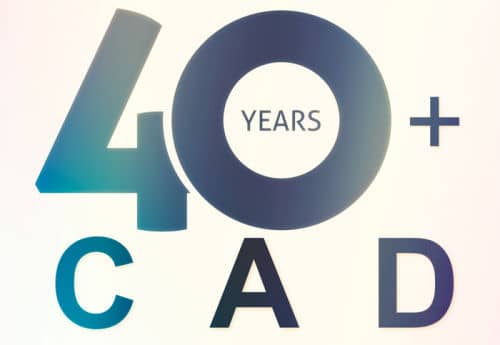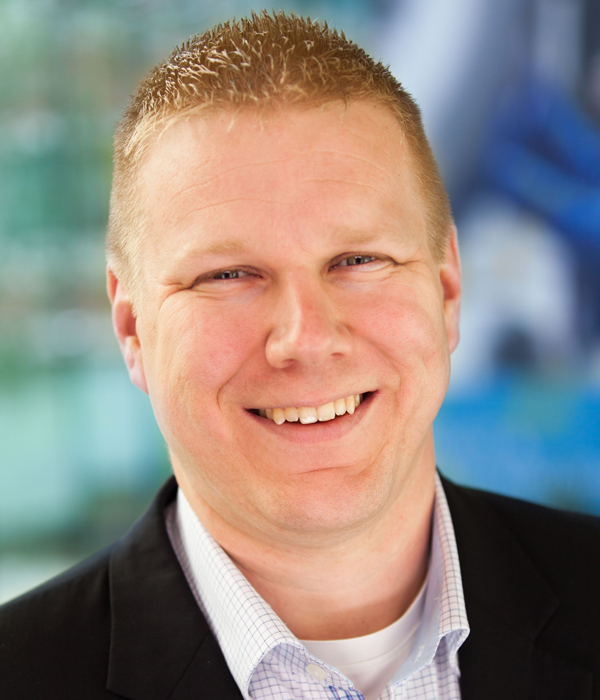
PTC has been one of the world’s leading CAD providers since the late 1980s and is now a major supplier of software for engineering, product lifecycle management, augmented reality, and IoT. Jim Heppelmann has been president and CEO of PTC since 2010.
Jon Hirschtick, also a CAD veteran, has been on board since the acquisition of the first pure cloud-based CAD system Onshape in October 2019. He was director of engineering at Computervision, manager at MIT CADLab, founder, and longtime head of SolidWorks before he co-founded Onshape.
Steve Dertien, as CTO, is responsible for driving the corporate technology strategy across the PTC businesses of AR/VR, IoT, CAD, PLM and innovation research.
I was lucky to talk to the three of them in a video interview in late January, 2022, for the PTC part of my series on “40+ years of CAD”.
PTC’s launch of Pro/ENGINEER with its parametric modeling concept was completely disrupting the business with solid modeling software in the late 1980s. The browser-based PLM concept of Windchill was the next milestone in the 1990s. Will the pure cloud-based CAD solution, Onshape, and its cloud platform, Atlas, disrupt the market again? It was very interesting for me to understand the product and technology strategy as explained by the top management in this interview.
The talk:
Ulrich Sendler: The history of CAD, for some people in the IT-business, seems to be old fashioned and boring. Is that also what you think?
Jim Heppelmann: Not at all! Of course, we at PTC are very proud of our CAD heritage because, as you know, PTC produced the first successful 3D parametric modeler. But we’re also excited about the fact that all these years later, we’re still investing significantly and innovating like crazy. It’s a very interesting market with an exciting history and an even more exciting future. Jon Hirschtick always says, “I don’t think we’re even half done yet,” and I tend to agree. This market is far from “over” if you will, even though it’s quite old.

Jim Heppelmann, president and CEO of PTC (photo PTC)

Jon Hirschtick, EVP and President of the Software-as-a-Service (SaaS) business unit (photo PTC)
Jon Hirschtick: It all started in 1962, with Ivan Sutherland’s PhD thesis, ‘Sketchpad’. Sutherland was a person who had vision with a capital V. He outlined so many concepts not just of 2D CAD but also around the interactive use of computers. You and I might think a constraint-based sketcher is new, but it was already in Sutherland’s thesis 60 years ago. Changes in computing systems – like raw materials in manufacturing – are new realities. We can build a new CAD system because of the evolution of computing systems from mainframes to minis, to workstations, to PCs, and now cloud, web and mobile.
PTC’s Pro/E utilized not only 3D solid modeling and a new paradigm, but it was also based on modern computing technology and the Unix workstation, a big landmark moment in the evolution. I remember being very impressed at the time. Today all systems in mechanical design use the Pro/E paradigm, and that is a statement I stood by even when I was at SolidWorks.
Jim: I think, even to this day, it’s an unbreakable principle. If you want to change a parameter, you just change your load condition, your material condition and the tool will recalculate the whole design with a zero-cost association. I think PTC has a legitimate claim to the modern era of 3D modeling because of the 3D interactive, parametric, associative, feature-based modeling that started at PTC. But while Pro/E was phenomenal, it was hard to use. It ran on $80,000 workstations, and it was hard to learn. But, as we know, Pro/E was incredibly powerful. Then Jon took the concept and built SolidWorks, which was much more democratic and widely available to masses of users.
Jon: We built SolidWorks on Windows and delivered ease-of-use, better pricing, different support, and different distribution. So, from a distance, why does the SolidWorks story look like the Pro/E story? Because at SolidWorks, we also took doing the right job for the user very seriously.
Jim: Then, in 2007, we acquired CoCreate, which you may remember was originally HP’s SolidDesigner software. We began evolving that direct modeling technology and developing role-based apps with specific functionality for use by the broad spectrum of people that form a company’s extended product development team. We knew that when these people are fully engaged throughout the lifecycle of a product, it’s much easier to increase productivity and improve operational efficiencies, which means our customers can get better products to market faster.
This new suite of capabilities was another industry-first for PTC. We branded our breakthrough technology Creo and released the first version in 2011. I don’t mind telling you, a lot of people thought we were taking a big risk by moving away from the Pro/E brand, but we knew that the over-abundance of features in Pro/E was overkill for many users and we wanted to offer a highly flexible and open solution that would solve usability, interoperability, assembly management and technology lock-in issues. The launch of Creo represented a huge technology advance in the CAD market.
PLM is the Brain of CAD
Ulrich: What were PTC’s other milestones to date?
Jim: Another milestone was when PTC acquired my company, Windchill. Windchill is a PLM, or product lifecycle management, system. PLM should be considered the brain that provides the CAD system with all the configuration possibilities that might exist. Here’s how I think of it; Volvo Trucks make the same engine that they put in trucks of several different brands, in buses, and in ships. They don’t need factories that build engines for trucks and other factories for boats and others for buses. Just one engine factory. That gives Volvo a tremendous operational advantage. A Volvo truck comes in literally millions of possible configurations. Windchill can manage all of these. A user might model five configurations, while 5,000,000 might be possible.
There’s a fork in the road here that’s important to understand. Creo and Windchill are trying to make it easy to reuse geometry millions and billions and trillions of times. Onshape is trying to solve problems for companies that develop products with short lifecycles. The needs of those customers are different. PTC offers Creo solutions for platform products and Onshape for what we call agile product development.
Ulrich: So, you are not planning to integrate Onshape with Creo?
Jim: No. We’re certainly not planning to merge them and make two products into one. We know that users have distinct needs, and we want to have a best-in-class product for each need. Just as Jon found a breakthrough with Windows, he found an equally significant breakthrough with cloud. Onshape complements Creo. Onshape isn’t a replacement. It will not be merged with Creo. Onshape solves a different problem that customers have.
Ulrich: Jon, you developed Onshape completely in the cloud from the beginning?
Jon: Yes, I could see the next generation computing system coming to be. Just think of Salesforce, Workday, Zendesk, NetSuite, Asana! I could see my children using those tools. I saw every competitor talking about cloud, but nobody was dedicated to developing for it, so we started building Onshape and, fast forward, that led us to becoming part of PTC.

Cloud-based Onshape enables agile product development any time, any place (photo PTC)
Ulrich: Which programming language do you use?
Jon: Onshape isn’t a program. It’s a collection of services, some written in Java, some in C++, Java Script, Web Client, etc. We may use some other languages too. It’s like a Symphony Orchestra of services or maybe more like a jazz band working together.
Onshape: Milestone in Education
Ulrich: Shortly after Onshape became part of PTC, the pandemic broke out. What happened with Onshape during the past two years?
Jim: To start, let’s look back at how COVID affected education around the world. To use CAD in a classroom setting, students have to use PCs, but students don’t typically own PCs, so they were all doing their CAD work on campus. Then COVID hit and most CAD classes around the world were cancelled from one day to the next.
And this is the beauty of the cloud; Onshape allows a student to work in the computer lab. After class, that same student could walk over to the library, open his laptop, and see the exact same model right where he left it in the lab. Later, he could take a bus home and during the trip, use his phone to see the model right where he left it on his laptop. And once home, he could use his parent’s computer to pull up the exact same model again with the very latest changes he made to it on his phone while riding the bus.
Jon: Let’s take a step back and realize that most students today don’t even know what a Windows workstation is, what files are, or what you mean if you say SQL. Steve, what about your kids?

Steve Dertien, CTO (photo PTC)
Steve: My kids don’t know what a file is. The idea of exporting and importing files is completely unknown to them. Their entire world is centered around search and collaboration. Jon, can you talk a little bit about the Onshape adoption we saw during COVID?
Jon: It was incredible. Adoption accelerated to over 1,000,000 users within months. Students, teachers, and professors switched to Onshape. We had circa 200,000 users across a period of several years and then we were suddenly at one million. The numbers continue to rise, but we are currently up to around 1,500,000 users.
Ulrich: What does Onshape run on?
Steve: It runs on both AWS and Azure. Most of Onshape is a highly distributed compute model on AWS.
Jon: We use the services that give us the best service for the customer.
Ulrich: Are we talking about micro services?
Steve: There are services that understand how to store and manage the data, services that understand the users. There are micro services that understand the workflow and the collaboration aspects. And then there are macro services. Geometry itself is a complex problem. Those services generally are far larger because you’re trying to execute the CAD functions correctly. But those services are highly distributed. We can launch thousands of them to deal with whatever work the users are doing.
In the middle of our talk Jim said to me: “Ulrich, I wanna give you a URL to write down. go to www.ptc.com/respirator” He wanted me to see the difference between the old CAD and the Onshape kind of CAD. Try it.
Take the Magic of Atlas and Use it for Creo and Much More
Jim: Onshape is built on a platform we call Atlas. And, frankly, Atlas provides the “magic.” We want to take that magic and use it within Creo as well. Onshape enables multiuser collaboration within the same design. It’s very different from classic paper-based version management. Every CAD system in PLM to date is a digital replication of paper.
Steve: Right – you put a version on it, stamped it, created the drawing, put it in a folder, released it. Now, the way Jon has built Onshape and subsequently what we put in Atlas, is more like software. We can do all sorts of things: compose, compile, merge, essentially generate any result that the engineer wants. Some CAD engineers used to fear making certain changes because of the ripple effect that might cause a break somewhere down the line. But with Onshape, that’s no longer a concern.
Ulrich: Can you talk a little bit more about Atlas as the cloud platform behind Onshape and Creo and other parts of your portfolio?

CAD model updates are instantly visible on all devices – phone, tablet, laptop, PC (photo PTC)
Jon: Just to clarify, when we built Onshape, we also called the platform Onshape, but have since renamed the platform Atlas to help differentiate between the CAD software Onshape and the cloud platform that other PTC products will be migrated to.
Jim: That’s very important. When we went to the PTC Board of Directors to ask for their approval to acquire Onshape, we said we are acquiring two things. First, a cloud platform, which we subsequently named Atlas, and a CAD system that runs on that cloud platform. But we envision that many of our other products will run on that cloud platform.

The roadmap for the PTC portfolio (Graphic PTC)
Ulrich: What’s the road map behind it? When do you think that Atlas will be the platform for most of your portfolio?
Steve: We anticipate being able to serve around one-third of our customer base by 2025 or 2026. Some of Creo is on Atlas now and within the next two years we expect to have most of Creo on Atlas.
Jim: We’re proceeding down the road map. Windchill starts this quarter. Creo will have a new delivery this year with Atlas features. If Parasolid is a geometry kernel, you could think of Atlas as a cloud kernel, or better, a cloud platform – a set of technology that would allow you to quickly build something new that already has all that power.
Today about 15% of PTC’s total business is software as a service. Our plan is that it will grow to 33% in five years, or three to four points per year.
Ulrich: Is Onshape also a solution for IoT projects?
Jim: That’s probably more in the Creo space today, but one of the services of the platform should be the ability to get real data from products in the field. That’s a feature that we’ve already delivered with Creo, not yet with Onshape, but we’ll be able to share those kinds of technologies.
Ulrich: Is Onshape the best tool for SMBs?
Jon: Don’t think about the size of the company. Whether Onshape customers are small or medium-sized is not the defining characteristic or even the correct question. The question is whether they are agile. Are they looking for agile processes to design hardware the way they design software? They may not actually call it agile, but that’s where the concept comes from. These customers want to do PDM without a PDM system. They need to release data, but not by copying files around and re-doing paperwork flows. There are even larger companies that want to change how they work. They say, we need to work faster, we need to be more innovative, we need to be agile. When you think of agile, you think of the rate of change in ideas.

Move fast with SaaS. All the capabilities of cloud-based CAD – on a phone (photo PTC)
Jim: Right! And that’s why we are not putting any limits on the functionality that Jon can develop in Onshape. Jon is building some of the most advanced technology such as generative design and agile versus platform. There is a famous quote from Jon. “Onshape is for startup companies and for companies that act that way.” BMW wants to act like a startup company. They’re not a small company, but they want to work differently. It turns out, many large companies say they should act like a startup company, work differently and be more agile.
Jon: I believe that much like what PTC did with Pro/ENGINEER, we’re doing again with cloud and Onshape, Creo, and other products on the roadmap. We’re developing and providing the fullest extension of what can be offered to engineers through CAD and I’m proud to be part of it.
